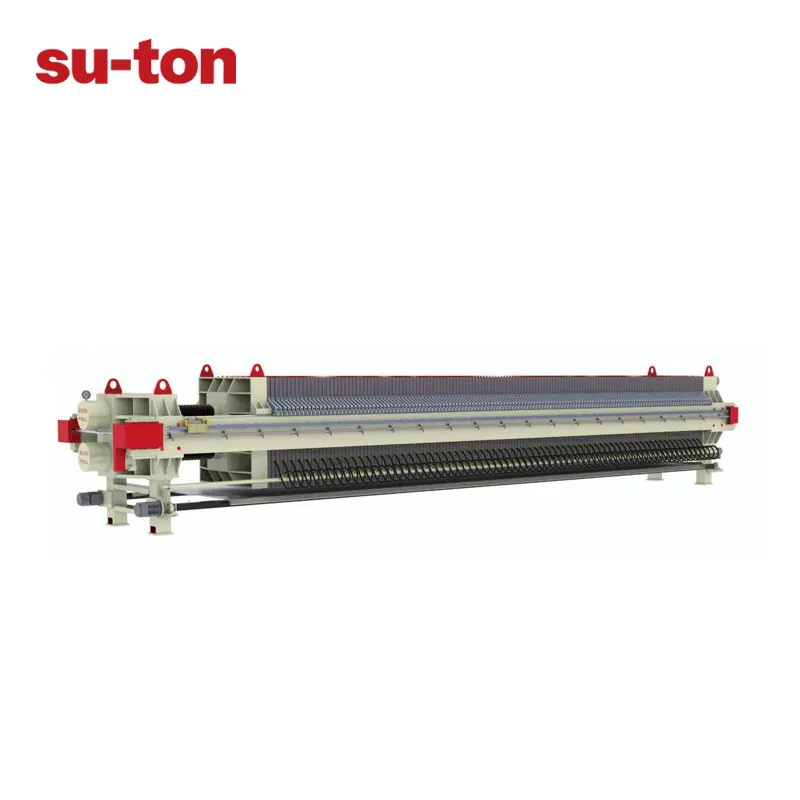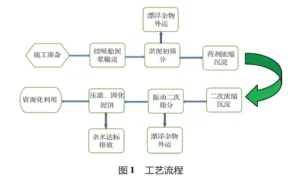Sludge Dewatering Filter Press
Sludge Dewatering Filter PressThe treatment equipment outputs the sludge formed by the slurry water formed in production, etc. The sludge is separated into mud blocks and recyclable water by the sludge dewatering treatment system, which can also be utilised twice.
River siltation has been increasingly affecting the normal performance of flood control, drainage, irrigation, water supply, navigation and other functions, in order to restore the normal function of the river, to promote rapid and sustainable economic and social development, it is necessary to carry out river dredging project. Make the river through the management of deeper, wider, clearer water, the masses of production conditions and living environment has been significantly improved.
River silt mainly exists in the form of muddy water with water content between 75%-90%, which increases the cost of dredging per unit of channel if transported directly; in addition, the muddy water is prone to leakage on the transport road, threatening the traffic environment.
1. Reliability of the overall design, i.e. timeliness of slurry handling, adaptability of slurry quality; and
2. Configure rich processing capacity and include the whole group with backup function equipment device.
3. Reliability of the performance, quality and service life of the equipment itself.
4. Each group of equipment is switched through the piping system and valve group for mutual backup.
Sludge Dewatering Filter Press Structure
Sludge Filter PressA group of filter chambers is formed by alternately arranged filter plates and frames. The surface of the filter plate has grooves, and its protruding parts are used to support the filter cloth. There are holes on the corners of the filter frame and the filter plate, which form a complete channel after assembly, and can pass into the suspension, washing water and lead out the filtrate. The plates and frames are supported by handles on each side of the beam, and the plates and frames are pressed by the pressing device. The filter cloth between the plate and frame acts as a sealing gasket. Suspension pressure is pressed into the filter chamber by the feed pump, and slag is formed on the filter cloth until the filter chamber is filled. The filtrate flows through the filter cloth and along the grooves of the filter plate to the corner channel of the plate and frame, and is discharged centrally. After filtration, the filter residue can be washed with clean washing water. After washing, sometimes compressed air is also passed to remove the remaining washing liquid. Subsequently, open the filter press to remove the filter residue, clean the filter cloth, re-press the plate and frame, and start the next working cycle.
Sludge dewatering filter presses are suitable for suspensions where the sludge is highly compressible or nearly incompressible. The concentration of solid particles in suitable suspensions is generally below 10%, and the operating pressure is generally 0.3 to 0.6MPa, with special ones up to 3MPa or higher. The filtration area can be increased or decreased with the number of plate and frame used. The plate and frame are usually square, the inner side length of the filter frame is 320-2000mm, the thickness of the frame is 16-80mm, and the filtration area is 1-1200㎡. The plate and frame are pressed by manual screw, electric screw and hydraulic pressure.
Sludge Dewatering Filter Press Filtration
The filtrate outflow adopts open flow filtration and dark flow filtration. In open-flow filtration, a spout is provided on the outlet hole below each filter plate, and the filtrate flows out directly from the spout. In submerged flow filtration, a liquid outlet channel hole is provided below each filter plate, and the liquid outlet holes of a plurality of filter plates are connected to form a liquid outlet channel, and the liquid outlet channel is discharged from a pipe connected to the liquid outlet hole below the thrust plate.
Sludge dewatering filter press washing method
When the filter cake needs to be washed, sometimes unidirectional washing and bidirectional flow washing, unidirectional washing and bidirectional submerged washing.
The surface of the filter plate is provided with pits and tabs to support the filter cloth. The filter plate is provided with through holes in the centre and corners, which, when assembled, form complete passages permitting the entry of suspension, washing water and filtrate. Handle supports are provided on the beams on each side of the filter plate, and the filter plate is pressed down by a compression device. The filter cloth between the filter plates acts as a seal.
Under pressure from the feed pump, the material to be filtered is fed into the filter chambers, where the solids and liquids are separated by the filter media (suitable filter cloths are selected according to the requirements of the no-operation). A filter residue is formed on the filter cloth until the filter chamber is filled with filter cake. The filtrate passes through the filter cloth and flows along the grooves of the filter plate to the lower outlet channel for centralised discharge. After filtration, clean wash water may be introduced to wash the filter residue. After washing, compressed air is sometimes introduced to remove the remaining wash liquor. After filtration, the filter press is opened, the cake is removed (the cake is stored between two neighbouring filter plates), the filter cloth is cleaned, and the plate filter is pressed again to start the next working cycle.
The filter cloth is fixed on the plate frame, which is the main form of the early filter press. The main advantage of chamber sludge filter press is that it is easy to change the filter cloth, and the disadvantages are low efficiency, poor filtration effect, and easy to break the filter plate. The filter chamber of chamber sludge filter press consists of two adjacent sinking filter plates, and the filter cloth is fixed on each plate.
The river dredging sludge filter press provides deep dewatering treatment for sludge, which can form sludge filter cake with low water content and realise sludge reduction. The river dredging sludge filter press produced by Sudong is an energy-saving filter press that can work continuously without the energy consumption of high-power motors, and can change from liquid to solid and complete the continuous output of sludge cake only by simple chemical reaction and physical-mechanical pressing, and can also meet the requirement of water content of filter cake.
After mud filter press dewatering, the water content of mud cake can be reduced to about 20%. Mud water into mud block, greatly reducing the amount of transport, but also easy to transport, reducing the adverse impact on the environment of the transport route. Under the premise of economy, safety and environmental protection, the centralised disposal and resource utilisation of river sludge can be achieved, realising the "reduction, harmlessness, stabilisation and resourcefulness" of sludge.
Slurry Dewatering Filter Press Industry Applications
1、Chemical industry: dyestuffs, pigments, caustic soda, chlorine muted monitor mud, silica, saponin, graphite, bleaching powder, Lide powder, phosphor, insurance powder, chloric acid powder, copper sulphate, manganese sulphate, ferrous sulphate, ferric hydroxide, water purifying agent (aluminium sulphate, polymerized aluminium chloride, alkaline aluminium chloride) and so on.
2. Medical: antibiotics (aureomycin, erythromycin, spiramycin, wellbutrin, madicin, tetracycline, safranin, hygromycin), calcium phytate, traditional Chinese medicines, myo-inositol, growth derivation yarns, organophosphorus, saccharomyces cerevisiae, and so on.
3、Foodstuffs: yellow wine, white wine, fruit juice, beverage, beer, yeast, citric acid, vegetable protein, vegetable molassesin, glucose, maltose, starch sugar, starch, rice flour, corn syrup, gum, carrageenan, monosodium glutamate (MSG), spices, sauce liquid, oral liquid, soya milk and seaweed, anaconda tablets, benadryl tablet and so on.
4、Metallurgy: gold ore, silver ore, copper ore, iron ore, zinc ore, rare earth and other powder beneficiation.
5、Oil refining: white oil, fragrance oil, light oil, glycerin, mechanical oil, vegetable oil, etc.
6, clay: kaolin, bentonite, activated clay, porcelain clay, electronic ceramic clay, etc..
7, sewage treatment: chemical sewage, smelting sewage, electroplating sewage, electrolytic sewage, leather sewage, printing and dyeing sewage, brewing sewage, pharmaceutical sewage, environmental sewage, paper sewage.
8、Coal beneficiation industry, tailing coal treatment, coking coal and so on.
Technical parameters
| FBXY 200-560/1500 400-1200/1800 Main performance/technical parameters: |
| Working filtration pressure | 0.4-0.6MPa |
| Maximum filtration pressure | 22MPa |
| Filter plate acid and alkali resistance | 2<PH<12 |
| Temperature resistance of filter plate | 0-100°C |
| Cake thickness | 32-35mm |
| valid itinerary | 1200mm |
| Diaphragm Pressure | 8-18MPa (subject to no material spray) |
| Area/Filter Plate | filter plate | capacity | power (output) | weights |
| mm | lump (of earth) | m³ | kw | kg |
| FBXY 200/1500 | 51 | 3.8 | 8 | 24300 |
| FBXY 220/1500 | 55 | 4.1 | 8 | 25660 |
| FBXY 250/1500 | 63 | 4.7 | 8 | 28250 |
| FBXY 280/1500 | 71 | 5.3 | 8 | 30920 |
| FBXY 300/1500 | 75 | 5.7 | 8 | 32100 |
| FBXY 320/1500 | 81 | 6 | 8 | 33950 |
| FBXY 340/1500 | 87 | 6.4 | 8 | 35860 |
| FBXY 400/1500 | 101 | 7.6 | 8 | 40400 |
| FBXY450/1500 | 115 | 8.5 | 8 | 45000 |
| FBXY500/1500 | 127 | 9.5 | 8 | 48860 |
| FBXY560/1500 | 143 | 10.6 | 8 | 54100 |
| FBXY 400/1800 | 69 | 7.6 | 8 | 47600 |
| FBXY 450/1800 | 77 | 8.5 | 8 | 51900 |
| FBXY 500/1800 | 87 | 9.5 | 8 | 57000 |
| FBXY 560/1800 | 97 | 10.6 | 8 | 62300 |
| FBXY 600/1800 | 103 | 11.4 | 8 | 64790 |
| FBXY 630/1800 | 109 | 11.9 | 8 | 67400 |
| FBXY 700/1800 | 121 | 13.3 | 8 | 73800 |
| FBXY 750/1800 | 129 | 14 | 8 | 77500 |
| FBXY 800/1800 | 139 | 15.2 | 8 | 82500 |
| FBXY 900/1800 | 157 | 17 | 8 | 93700 |
| FBXY 1000/1800 | 175 | 19 | 8 | 96000 |
| FBXY1100/1800 | 191 | 20.9 | 8 | 105800 |
| FBXY1200/1800 | 209 | 22.8 | 8 | 118600 |
| Remarks: | The final explanation of this product belongs to su-ton and is subject to change without prior notice.
|
| Sales Calls: | TEL:18118100011 |
To learn more about our products, please contact our engineers: 188-517-18-517 for your customised solutions.
Contact Us
Sales:181-181-000-11
Selection:188-517-18-517
Mailbox:suton@su-ton.com
 Plate and frame chamber diaphragm filter presses
Plate and frame chamber diaphragm filter presses




